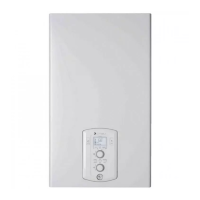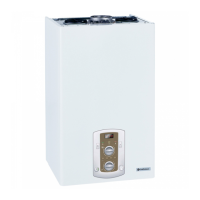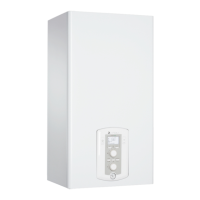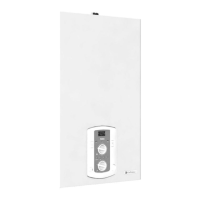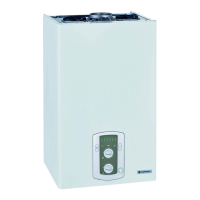Advice for the installer
The installation and rst ignition of the boiler must be performed
by qualied personnel in compliance with current national
regulations regarding installation, and in conformity with any
requirements established by local authorities and public health
organisations.
After the boiler has been installed, the installer must ensure that
the end user receives the declaration of conformity and the oper-
ating manual, and should provide all necessary information as to
how the boiler and the safety devices should be handled.
This appliance is designed to produce hot water for domestic use.
It should be connected to a heating system and a distribution network
for domestic hot water, both of which must be compatible with its
performance and power levels.
The use of the appliance for purposes other than those specied is
strictly forbidden. The manufacturer cannot be held responsible for
any damage caused by improper, incorrect and unreasonable use of
the appliance or by the failure to comply with the instructions given
in this manual.
Installation, maintenance and all other interventions must be carried
out in full conformity with the governing legal regulations and the
instructions provided by the manufacturer. Incorrect installation can
harm persons, animals and possessions; the manufacturing company
shall not be held responsible for any damage caused as a result.
The boiler is delivered in a carton. Once you have removed all the
packaging, make sure the appliance is intact and that no parts are
missing. If this is not the case, please contact your supplier.
Keep all packaging material (clips, plastic bags, polystyrene foam, etc.) out
of reach of children as it may present a potential hazard.
In the event of a fault and/or malfunction, turn the appliance o, turn
o the gas cock and do not attempt to repair it yourself. Contact a
qualied professional instead.
Before any maintenance or repair work is performed on the boiler,
make sure you have disconnected it from the electricity supply
by switching the external bipolar switch to the “OFF” position and
removing the fuse.
All repairs, which should only be performed using original spare parts,
should be carried out by a qualied professional. Failure to comply
with the above instructions could compromise the safety of the
appliance and invalidate all liability on the part of the manufacturer.
In the event of any maintenance or other structural work in the
immediate vicinity of the ducts or ue gas exhaust devices and their
accessories, switch the appliance o by switching the external bipolar
switch to the “OFF” position and shutting o the gas control valve.
When the work has been completed, ask a qualied technician to
check the efficiency of the ducting and the devices.
Turn the boiler o and turn the external switch “OFF” to clean the
exterior parts of the appliance.
Clean using a cloth dampened with soapy water. Do not use
aggressive detergents, insecticides or toxic products. If the appliance
is used in full compliance with current legislation, it will operate in a
safe, environmentally-friendly and cost-efficient manner.
If using kits or optional extras, make sure they are authentic. CHAF-
FOTEAUX.
Before connecting the boiler, take the following into account:
• the equipment must not be installed in areas where the combustion
air contains high chlorine levels (such as near a swimming pool), and/
or other dangerous substances, such as ammonium (hairdresser) or
alkaline agents (laundrette), etc.
• ensure that the boiler is designed to operate with the type of gas
available (read the information label on the packaging and on the
boiler specications plate)
• check the labels affixed to the packaging and the data plate on the
equipment to ensure that the boiler is designed for the country in
which it is to be installed and that the category of gas for which the
boiler has been designed corresponds to one of the categories autho-
rised in the country concerned.
Before installing, we recommend that the gas inlet is cleaned thorou-
ghly to remove any residue which could impair the operation of the
boiler.
It is also important to check that the gas pressure of the boiler is com-
pliant.
Check that the maximum pressure of the water supply does not ex-
ceed 5 bars. Otherwise, a pressure regulator must be tted.
For areas where the water hardness is greater than 20°f, a water treat-
ment process is recommended.
Recommendations:
If the area is exposed to risk of lightning (isolated installation at end of
ENEL line, etc.) provide a system to protect against lightning.
Our guarantee is subject to this condition.
LOCATION OF BOILER
- never install the boiler above cooking surfaces in kitchens, ovens
and, generally, above any sources of fatty vapours which are likely
to impair the satisfactory functioning of the boiler because of
possible clogging.
- ensure that the wall and xing accessories are strong enough to
support the weight of the boiler (weight: approximately 45 kg)
- take the necessary precautions to limit undesirable noise.
Warning:
In order to avoid compromising correct boiler functioning the place of
installation must be suitable in relation to the value of the operating
temperature limits and be protected so that the boiler does not come
into direct contact with atmospheric agents.
DESIGNING AND CARRYING OUT INSTALLATION
Domestic hot water circuit.
If the water is harder than TH 25, include a treatment system.
Main heating circuit.
Heating circuit ow: When determining the dimensions of the
pipework, take into consideration a minimum ow of 300l/h, with the
valves o.
Anticorrosion precautions.
If the system is produced with non-uniform sections, operational
problems attributable to corrosion may occur.
To avoid these problems, the use of a corrosion inhibitor is
recommended.
Take every practical precaution to avoid the treated water taking on
aggressive characteristics.
Old installations: position a decanting container on the return and at
the lowest point, then provide adequate treatment for the circuit.
The recommendation is to provide air venting valves on all radiators
and on the high points of the system and discharge valves on the low
points.
